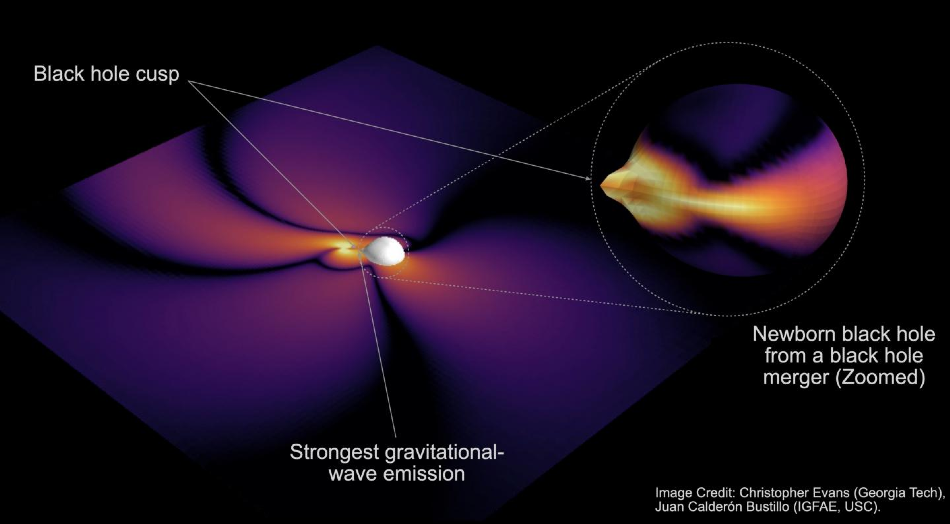Oct 9 2020
Among the most captivating things in the universe, black holes are interesting candidates. Their surface is called the “event horizon,” and the gravity at the surface is so powerful that it does not allow even light to escape from them.
 Artist’s illustration of a black hole cusp. Image Credit: C. Evans and J.C. Bustillo.
Artist’s illustration of a black hole cusp. Image Credit: C. Evans and J.C. Bustillo.
In general, black holes are silent, placid creatures that gobble anything that reaches too close to them. But the collision and merger of two black holes creates one of the most devastating events in the universe: a highly deformed black hole evolves within a fraction of a second and discharges enormous amounts of energy while morphing into its final form.
This phenomenon offers astronomers a unique opportunity to view black holes that change fast and investigate gravity in its most extreme form.
Despite the fact that colliding black holes do not generate light, astronomers can view the detected gravitational waves—which appear as ripples in the space-time fabric—that get scattered off them. Researchers propose that, following a collision, the activity of the remnant black hole is crucial in gaining insights into gravity and should be encoded in the discharged gravitational waves.
In the paper published in Communications Physics (Nature), a research team led by OzGrav alumnus Prof. Juan Calderón Bustillo, who is now a “La Caixa Junior Leader – Marie Curie Fellow” at the Galician Institute for High Energy Physics (Santiago de Compostela, Spain), has demonstrated how gravitational waves decipher the shape of merging black holes while they take their final form.
We performed simulations of black-hole collisions using supercomputers and then compared the rapidly changing shape of the remnant black hole to the gravitational waves it emits. We discovered that these signals are far more rich and complex than commonly thought, allowing us to learn more about the vastly changing shape of the final black hole.
Christopher Evans, Study Co-Author and Graduate Student, Georgia Institute of Technology
The gravitational waves emitted from colliding black holes are very simple signals called “chirps.” When the two black holes come near each other, they give out a signal of increasing frequency and amplitude that denotes the radius and speed of the orbit.
Prof. Calderón Bustillo explains that “the pitch and amplitude of the signal increases as the two black holes approach faster and faster. After the collision, the final remnant black hole emits a signal with a constant pitch and decaying amplitude—like the sound of a bell being struck.” This principle is in agreement with all gravitational-wave observations performed to date while analyzing the collision from the top.
But the study discovered that something totally different occurs upon observing the collision from the final black hole’s “equator.”
When we observed black holes from their equator, we found that the final black hole emits a more complex signal, with a pitch that goes up and down a few times before it dies. In other words, the black hole actually chirps several times.
Juan Calderón Bustillo, Professor and La Caixa Junior Leader – Marie Curie Fellow, Galician Institute for High Energy Physics
The researchers determined that this is associated with the shape of the final black hole, which serves as a type of gravitational-wave lighthouse: “When the two original, ‘parent’ black holes are of different sizes, the final black hole initially looks like a chestnut, with a cusp on one side and a wider, smoother back on the other,” added Bustillo.
It turns out that the black hole emits more intense gravitational waves through its most curved regions, which are those surrounding its cusp. This is because the remnant black hole is also spinning and its cusp and back repeatedly point to all observers, producing multiple chirps.
Juan Calderón Bustillo, Professor and La Caixa Junior Leader – Marie Curie Fellow, Galician Institute for High Energy Physics
According to Prof. Pablo Laguna, co-author of the study and former chair of the School of Physics at Georgia Tech and, currently, professor at the University of Texas at Austin, “while a relationship between gravitational waves and the behaviour of the final black hole has been long conjectured, our study provides the first explicit example of this kind of relation.”
Journal Reference:
Calderón Bustillo, J., et al. (2020) Post-merger chirps from binary black holes as probes of the final black-hole horizon. Communications Physics. doi.org/10.1038/s42005-020-00446-7.